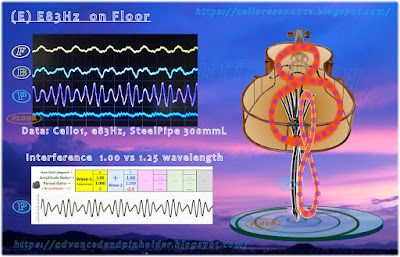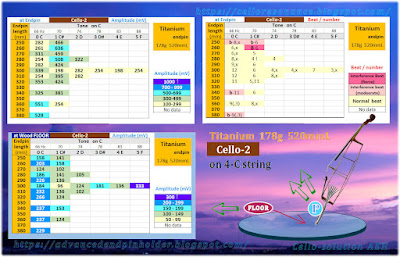[ 12/01/2022 ] [ 01/08/2023 ] Labels: 77b.Resonance-II
How does cello sound dance inside/outside the body?
Cello sound will be carefully observed just outside the body by four(x2 pattern) unidirectional microphones by keeping 0.1mS measurement precision.
There seems to be two types on tones-- A:omnidirectional tones and B:directional tones --
Typical A:group tones are seen at E(166Hz) and its around.
「音の踊り」
チェロの筐体の外側(できる限り近い位置)に指向性マイク([A] [B] [C] [D] 、(e) (f) (g) (h))を配置して 0.1mS(1/10000秒、音速距離としては3-4cm)の精度をキープしながら音を拾ってみよう。
第一印象としてチェロの音には、A:無指向性の音と B:方向性のある指向性の音のグループがあるようだ。A:の代表例は E(166Hz)とその付近で見られる。
9B0. Resonance-II [ Measurement point ]
Advanced Endpin Holder on SALE

On sale at: (販売中)
Amazon.com
Advanced Endpin Holder for Cello AEH-011 ASH-white
Advanced Endpin Holder for Cello AEH-012 WALNUT-black
Advanced Endpin Holder for Cello AEH-112 Walnut Resonance Response Solution
Amazon.co.jpアドバンスト・エンドピンホルダー AEH-011 ASH-white
アドバンスト・エンドピンホルダー AEH-012 WALNUT-black
アドバンスト・エンドピンホルダー AEH-112 Walnut Resonance Response Solution
アドバンスト・エンドピンホルダー AEH-113 Oak Resonance Response Solution
アドバンスト・エンドピンホルダー AEH-114 Maple Resonance Response Solution
9AD. Lowest Tone C(66Hz) - Floor vs AEH -
[ 11/08/2022 ] Labels: 77a.Resonance-study
(4)Advanced Endpin Holder
holds a cello in the air, leaving room for the tip of endpin to vibrate, then reduces the mechanical vibration between the endpin and the cello body, then recovers natural and rich resonance on cello.
(4)AEHによる改善効果
AEHによりチェロを床から縁切りしてエンドピン先端に自由な振動を許すと、一般にエンドピンの物理的振動は抑えられ、逆にチェロ筺体の共鳴音量が増加・回復する。
9A9. Lowest Tone C(66Hz) - On-Floor Resonance -
[ 11/08/2022 ] Labels: 77a.Resonance-study
(3)Resonance of cello's lowest tone C(66Hz) on the floor
is observed as below compared with Without-Endpin case:
a.The amplitude of the resonance sound decreases to almost half.
b.The waveform flattens.
c.Endpin(or Endpin-Tailpiece alliance) seems taking mechanical resonance with cello body then bringing a complicated situation.
d.Sometimes fierce interference beats are seen on endpin. In this case, C(66Hz, WL=5.2m) probably interferes with the redundant WL (: C(5.2m) plus endpin round-trip length).
e.Endpins can mechanically resonate with almost every semitone around C(66Hz), because the characteristic frequency as a endpin(pipe/rod) is expected to exist around 1700-1800Hz.
(3)床置きした時のチェロの最低音の響き
エンドピンを装着・床置きして C(66Hz)のロングトーンみると、一般的に
a.発生音の波形の振幅(発生音の大きさ)が半減する。
b.全体として平坦な振動波形となる。
c.エンドピン(エンドピン+テールピース)とチェロ(筐体)が機械的に共振している(影響しあって複雑な振動を生んでいる)ように見える。
d.エンドピンに大きく顕著な機械的振動が見られる。大きなうなりを伴うことが多い。
エンドピン自体が振動波長のルートに組み込まれ、その冗長波長と干渉していると考えられる。
e.本来エンドピンの棒としての基本振動数が1700-1800Hz付近に存在すると考えられ、床に片端を固定され増幅されることにより、エンドピンは最低音C(66Hz)付近では全ての半音(低音側倍音)に対して大きく共振してもおかしくないだろう。
9A4. Lowest Tone C(66Hz) - Synthesis -
[ 10/24/2022 ] Labels: 77a.Resonance-study
(2)Cello Lowest Tone(C66Hz) Synthesis Simulation
Synthesis simulation was studied for the lowest tone(C66Hz) on MS-Excel.
Cello body cannot create C(66Hz, WL=5.2m) nor the octave C(131Hz, WL2.6m) 8-shape resonance orbits inside because of its long wavelength. However, G(197Hz) and/or the upper "overtone sets" can synthesize C(66Hz, 5.2m) long combined orbit when the total of the wavelength just meet 5.2m. The solution is not limited one way. For instance:
(a)2xG+1xC+1/2xE--> C(5.2m, 3sub-beat, E is taking initiative),
(b)1xG+2xC+1/2xE+1/2xG--> C(5.2m, 4beat),
(c)1xG+1xC+2xE--> C(5.2m,5beat),
(d)1xG+1xC+1xE+1xG--> C(5.2m, 6beat),
(e)1xG+1xC+1xE+2xC--> C(5.2m, 8beat),
In other words, cello body is supposed to be able to create all upper semitones/pitch by real single 8-shape orbits and also for lower tones/pitch by virtual way(double orbit or overtone combination orbit) .
Really cello body seems a fantastic invention.
(2)チェロの低音の合成シュミレーション
Celloの最低音C(66Hz)を例にとって MS-Excelを使って合成シミュレーションしてみる。
チェロの筐体はC(66Hz,波長5.2m)及びその1オクターブ上のC(131Hz,波長2.6m)をシングルな8形の軌道として筐体内に作ることができない。波長が長すぎるためだ。しかし G(197Hz)以上の倍音成分をだけを使って積み重ねてみると、その倍音成分の波長の長さの合計がちょうど 基音C(波長 5.2m、正確には整数倍)になる場合に、基音C(66Hz, 5.7m)の合成波形を作ることができる。上方の倍音セットがあれば低音を作り出せることを示している。
方程式の解は一通りではなく複数存在する。その時の倍音構成により 1周期中のビート数が決まるようである。逆にビート数/波形パターンをみるとその時響いている倍音構成がわかることになる。例えば 3, 6 ビートが見られたら "G"が、4, 8 なら "C"が、5 なら Eがイニシャチブを取っていることになる。実測のチャートと符合する。
チェロはちょうど半分から上の共鳴(振動数)を使って下方の全ての共鳴をも作り出していると考えられる。先人達は実に画期的な楽器(筺体)を発明したものである。
9A0. Lowest Tone C(66Hz) - REVIEW -
[ 10/23/2022 ] Labels: 77a.Resonance-study
(1)Cello Resonance Review
Cello's resonance route/orbit is divided into four groups(I - IV) as also posted before. The most vital tone/pitch exists at around D#(156Hz)-E(166Hz), taking a single 8-shape orbit along maximum bouts fence dimension. Wolf-tones are often observed at 5-10 % upper frequency of D# - E. Cello can resonate with any pitches consecutively at I, II area. The double orbit of II can compensate the adjacent lower octave tones(Area III).
Although cellos cannot perform directly their long wavelength(IV tone area, C(66Hz),C#,D,) inside the body, we can actually listen the rich resonance when endpins are not installed.
Typical waveforms including 4 - 6 sub-waves are commonly seen inside the C(66Hz) cycle period. In fact, these are the C(66Hz)'s unbalanced upper overtones, it will be discussed later.
(1)チェロの響き [ REVIEW ]
過去にまとめたように、チェロの筐体内の共鳴ルートは、I - IV の4つのエリア/グループに分けられる。最もキーとなるのは中央音域にあるウルフトーンの発生する音域である。ウルフトーンの半音程度下方にチェロ筐体が8の字軌道で作りえる最長波長(2.2m,D#近辺)が存在する。それよりも高音域(I, II)では任意の波長に対応して共振可能な8の字のルートを作ることができる。その下の1オクターブ(III)は2周回することにより任意の波長の共鳴ルートをとることができる。
しかし、最低音(エリアIV: C,C#,D・・)では直接的な共振ルートを作ることができない。C(66Hz)-エンドピンなしの場合-の代表的な共振波形をみてみると、基音-基音間に4-6ケ程度のサブ振動を含みながら しかし極めて起伏の大きい(リッチな響きを意味する)振動をしていることがわかる。このサブ振動は実はC(664Hz)の高音側の倍音(ただし変則的)を示している。
Cello Response (#7)
[ 8/25/2022 ] Labels: 96.Video & Study2
Cello RESPONSE is describable a result of "Newton's laws of motion". The key is the aligned mechanical resonance between TAILPIECE and ENDPIN, taking some delay from strings. Too quick bow speed leads the resonance energy into endpin preferentially.
The true direct reason is hidden at the floor that restricting the tip of endpin. If you allow free vibration to endpin tip your cello response will revive dramatically.
レスポンス、深く関係するのは「ニュートンの運動方程式(F=ma)」である。観察してみると少々込み入っているようだ。
(1)時としてテールピースとエンドピンが連携してあたかも質量を共有しているように共振する
(2)エンドピンは弦と直接接続していないので共振に「遅れ」が生じる
(3)必要以上に速い弓はテールピース→エンドピンのルートでエネルギーが流出する
(1)-(3)の挙動を増大させているのは床がエンドピンの先端を固定していることに起因する。ピン先を自由にすることによりチェロのレスポンスは劇的に改善する。
( CELLO : Kinue NAKAHARA )
Cello Resonance -#6- SUMMARY
[ 7/21/2022 ] Labels: 96.Video & Study2
Cello's '8-shape' resonance body, that can resonate any pitches keeping them inside. Endpins mechanical resonance contrary depends on the endpin length and given pitches.
チェロの筐体はあらゆる連続するピッチを共鳴させることができる。一方、エンドピンはその長さと与えられるピッチによって挙動が異なる。
( CELLO : Kinue NAKAHARA )
Cello Resonance (♯5) AEH SOLUTION
[ 7/04/2022 ] Labels: 96.Video & Study2
Advanced Endpin Holder improves resonance and response.
Please try AEH and add to your repertoires the improved resonance and response world.
( CELLO : Kinue NAKAHARA )
Resonance Study (#4) Endpin Resonance
[ 5/28/2022 ] Labels: 96.Video & Study2
We know every string, pipes, wind instruments can be defined their frequency(/tones) by being determined two ends or the length.
Cello endpins behave as same. Then mosaic-like vibration effects from the endpin are added back on the original cello sound.
弦・パイプ・管楽器(wind instruments)、2点またはその長さを決めると共振する周波数(音程)が決まる。
奏者はその音を最大限響かせながら周囲に伝えたい時、楽器を空中に保持する。
一方、チェロのエンドピンはどうでしょうか。床の上に置いて2点(両端)を固定して使う。エンドピンはその長さ・材質・与えられる周波数に応じて共振し、その共振タイミングと振動数はモザイク状のサウンドエフェクトのようにチェロの音質や響きに影響する。
( CELLO: Kinue NAKAHARA )
Cello Resonance -#3- Interference and Wolf Tone
[ 4/30/2022 ] Labels: 96.Video & Study2
Cello's '8-shape' resonance body, that can resonate any (and continuous) pitch keeping them in its inside, is a great invention.
However, cello was destined to share a wolf tone at its center range instead. This one point discontinuity seems a compensation that the infinite is confined in the finite. ( Cello : Kinue NAKAHARA )
チェロ(バイオリン族)の8の字型の筐体、それはあらゆる(しかも連続した)ピッチを共鳴させることができる画期的な発明品である。しかし同時に、ウルフトーンという"干渉うなり"を音域の中央付近に持つことになった。それは「無限」を「有限」な箱に閉じ込めようとした代償のように見える。
Cello Resonance Study (♯2) Sound Speed
[ 4/06/2022 ] Labels: 96.Video & Study2
How the pitch is settled.
7A-33 Low tone resonance - 4 -
[ 2/03/2022 ] Labels: 53.Endpin-Resonance3
This post is the last report on Endpin-Resonance study series, commented on low tones E(83Hz)-F(88Hz) on C string.
We can see two typical resonance patterns in this area. Sometimes harsh influence to floor is observed on this spot.
The first pattern is the same as being seen at C-D tone(:accompanied with interference beats). For example, interference between E(83Hz, 4.11m-wavelength) and 'E + endpin length'(: 4.1 + 1.0 = 5.1m :redundant wavelength ) was sometimes seen on the endpin.
The second pattern relates to endpin's two-ends resonance. In this case, for instance, rather narrow F(88Hz) resonance orbit shifts the resonance angle along backward and forward in the cello body, then endpin delivers the swing to its two ends. This physical vibration sometimes seems bringing harsh impacts to the floor.
エンドピン共振の一連の調査の最終として、C線の E(83Hz)-F(88Hz)付近についてまとめる。
エンドピンの振動が床に伝わっている第2のスポットである。ここでは特徴的な二つの振動パターンが見られる。
第一は C-D音で見られたのと同様なきつい干渉振動がエンドピンに観察される場合であり、第二はにエンドピンの中央はほとんど振幅が無いのにピン先(正確には両端)で大きな振動となり床を叩いているような場合である。
第一の干渉が起こっている場合は、例えば E と E+1.0m の二つの波長(振動数)が干渉している。つまり、エンドピンの全長が加わった(ピッチが大幅に下がった)波長・ルートが存在する。
第二の場合は、筐体内で 2ビートで共振する8の字軌道(=波長が短くなるので、振動方向が筐体の前後方向に移ってきている)に物理的に共振してエンドピンの両端も2ビートで前後方向に共振している場合である。この時の床への衝撃は大きい。
7A-32 Lowest tone resonance of cello - 3 -
[ 1/27/2022 ] Labels: 53.Endpin-Resonance3
(1) REVIEW-1: Cello tones :D#(78 Hz) to D(147 Hz) are presumed taking a two times '8'-shape-circling-orbit along the upper octave orbits. Actually, observing oscilloscope shows a typical two beats in a cycle period.
(2) REVIEW-2: The lowest tones: C(66Hz) to D(74Hz) has unfortunately a longer wavelength than the 'two-cycle-orbit'. If the cello is floating in the air, a very unique solution is adopted: Many upper overtone orbits are linked then makes an fundamental-tone-equivalent wavelength. The typical sample is the C(66Hz, wavelength=5.18m). Sometimes C(5.18m) is assembled as G(198Hz,1.73m)+C(263Hz,1.30m)+E(331Hz,1.04m)x2. Wave-synthesis simulation results sometimes well match to the real sound waveform. C(131Hz) never participates as a candidate because the actual C(131Hz) orbit does not exist in the cello body.
(3) When a cello placed on the floor, actual oscilloscope study indicates A)fading overtone assemblage in sound and B)remarkable interference beats on endpins. In many cases the interference beats are cast as a synthesis of two original different frequency. The ratio was usually 1.1 or 1.2, for instance, 5.18m(C66Hz) vs 5.18m + 'endpin length(0.5m)' x2 can make the ratio as 1.2. The real orbit/route in a cello seems prior to the virtual orbits inside the cello body. Endpins are now a part in cello. Usually, endpins do not create a real sound but sometimes generates an unpleasant interference beats at the endpin, then the beats sometimes fiercely impact on the floor
(1) 復習-1: D#(156Hz)よりも低トーンでは筐体内でどのように共鳴しているかと言えば、上側の1オクターブで取っている8の字軌道を2周していると考えられる。実際に音波形を調べると基本的に"2ビート"であることから解る。
(2) 復習-2: 最低音C(66Hz)-D(74Hz)では、そのトーン波長が8の字を2周しても筐体内に収まらない。エンドピン無しで空中で演奏される時、チェロはその解決策として上方の(高音)倍音を複数組み合わせてバーチャル軌道を採用しているように見える。ちなみに、C(66Hz)の場合、例えば、G(197Hz) + C(263Hz) + E(331Hz)x2 = C(66Gz,5.18m波長と同じ長さとなる) を取ることが多いようだ。波の合成シミュレーション波形とよく一致する。ここで、C(131Hz)倍音は含まれない。なぜならこの軌道は成立しないから。
(3) エンドピン付きで床置きした場合はどうであろうか。観察してみると筐体から放出される(倍音)バーチャル軌道波形(,音)の比率は低下し、代わってエンドピンの顕著な機械振動が目につくようになる。エンドピンに激しいうなりを伴う干渉波形が見られる場合が多い。シミュレーションによれば、8の字x2周 + エンドピン全長x2(=1.2) と 8の字x2周(=1.0) の波長がエンドピンで干渉していると推定される。つまり、余った波長長さがエンドピン往復(1回)の距離を使って帳尻を合わせている形である。バーチャル軌道よりもリアル軌道が優先され、エンドピンが楽器の一部になっていることを意味している。エンドピンは振動しても音はほとんど生成しない。その干渉波は条件がそろうと、与えられる周期に呼応してエアハンマーのように床に伝わることになる。これが床を揺らすチェロの低音の一因であると考えられる。

7A-31 Review - Cello Wolftone -
[ 1/21/2022 ] Labels : 53.Endpin-Resonance3
As the beginning of cello low tones study, let's review first the wolf-tone around E(166Hz).
D#-tone(156Hz, Period=6.40mS, Wavelength=2.18m) is very special for 4/4-full-size cellos, because D# is the lowest note that a cello can adopt a flawless simple '8'-shape resonance orbit(-as the longest route-) inside the cello body. Just inside the cello body the perimeter of the bouts wall is 2.18 meter. It is just the same to D# wavelength in the air.
E or F tone takes a little bit shorter wavelength(/slender orbit) instead, so that the orbit of E/F is rather unstable. The echo from the new born E/F resonance runs off from the original orbit swiftly then gathers to just inside the bouts wall, because the sound travels straight in the air. If D# echo is enhanced up to almost equal to E/F resonance amplitude and the two wavelength takes about 10-20% apart, a harsh wolf-tone(interference beat, including no-sound moments) suddenly comes out.
An elaborately manufactured cello can have a beautiful '8'-shape resonance orbit in the body. Probably the wolf-tone is related to the original design/structure.
The interference phenomena occur inside the cello body and in the air, so the unpleasant wolf-wave travels through the air. In this case endpins are not related directly.
チェロのウルフトーンのメカニズムを復習しておこう。
チェロの中心音域のD#音付近(156Hz, 周期=6.40mS, 波長=2.18m)はチェロにとって特別である。チェロの筐体内の響きが(1周の)8の字軌道でとりうる最低音(最長の波長)である。一般的な4/4サイズのチェロでは 延長=2.18メートル程度であり、ちょうどD#付近の(大気中の)波長と一致する。
これに対して E(166Hz),F(175Hz)では波長が若干短い。不幸なことにE音のエコーは、1周回した時、そのエコーは軌道を少し大回りして外側に膨らんでしまう。なぜなら物理法則によれば音は直進するからである。側板の壁がエコーを閉じ込めるために残響が壁の内側に高濃度に集まることになる。残響はD#軌道となり、生まれた直後の響きとエコーの波長差が 6-12%で 振幅強度がほぼ同等な時、干渉が最大(音が一瞬消失)となる現象が起こる。これがウルフトーンであると考えられる。
左右均等に丁寧に製作された美しい筐体の楽器は豊かな残響を持つ。しかしウルフはその分きつい。その意味でウルフトーンはチェロという楽器(8の字系筐体)の構造上の問題でありデザイン上の問題であるとも言える。
また、E,F,G,G#あたりまでD#のエコーとの干渉は弱くなっては行くが連続して見られる。干渉が筐体内で起こるためにうなり・ウルフは音として放出される。この時エンドピンは直接関与しない。
7A-30 Endpin-Floor Resonance -2-
[ 1/16/2022 ] Labels: 53.Endpin-Resonance3
Endpin-Floor resonance was checked up on cello low tones.
The outline is here and details will be on later posts.
(1)Floor resonance seems very capricious. Favorable conditions sometimes assemble an energetic resonance on the floor.
(2)There seems to be two remarkable resonant areas.
[A]:C(66Hz)-E(83Hz), accompanying a typical interference beats on the endpin, taking 1-beat, same pitch to the fundamental tone. This mechanism is probably similar to 'wolf-tone'.
[B]:E(83Hz)-G(98Hz), the 2-beat(or 3- 4-beat) impact brought by perfect body-endpin resonance of 2-beat.
(3)The resonance amplitude/intensity of the floor might be depend on the direction the endpin resonates.
2台のチェロと3本のエンドピンで、チェロの低音(C - F)について、エンドピンと床の共振関係の全体像をまとめた。
床の振動を正確に調べるのは難しいが、全体像は把握可能である。次の傾向が見えてきた。
(1)床の振動(共振)は'気まぐれ'である。通常ほとんど床へは大きな振動は及ばない、しかし一定の条件が重なると極めて大きなエネルギーが床に流失する場合があるようだ。
(2)床が大きな振動を得るのは主に2エリアである。[A]:C(66Hz)-E(83Hz)でエンドピンに大きな'干渉うなり'を伴う場合、[B]:E(83Hz)-G(98Hz)で筐体・エンドピンとともに同期をとって2ビート(または 3- 4-ビート)でぴったり共振する場合、で見られる。[A]の場合は演奏される音と同期・同ピッチの1ビートであり、1オクターブ上で起こるウルフトーンと良く似ている。
(3) [A][B]のメカニズムは各々異なっているようだ。床を大きく揺らすか否かは、エンドピンの共振する方角と関係があるかも知れない。
この後詳しく解説を試みる。
7A-29 Floor and Low tones Resonance -1-
[ 1/13/2022 ] Labels: 53.Endpin-Resonance3
Now, we shall study the cello resonance for the lowest tones(:C, C#, D, E, F..) with associating to endpin and floor.
Many kinds of finding/phenomena that we have already posted last year seem all relating and seen in this low tone area like a diorama. i.e. '8-shape' resonance orbit, wolf-tone, interference beat, endpin(rod) resonance etc.
チェロの低音共振と床振動について調べる。
ほぼこの1年間、(a)チェロの筐体の共鳴(8の字共鳴軌道)、つづいて(b)エンドピンの共振について調べてきて、多くの収穫があった。最後に、(c)低音域における筐体共鳴と床の振動について改めて詳細な調査を行い、この一見混沌としたエリアで何が起こっているか考察してみる。
この(c)域の特徴は、チェロにエンドピンを装着して床上で演奏すると、全般としてチェロの響きが委縮してしまうことと、時として床に大きな振動を放出する(ことがある)点が特徴だ。
調べていくと、このエリアは、(a)(b)を含めてチェロ・エンドピンの共振像の縮図のようである。


























